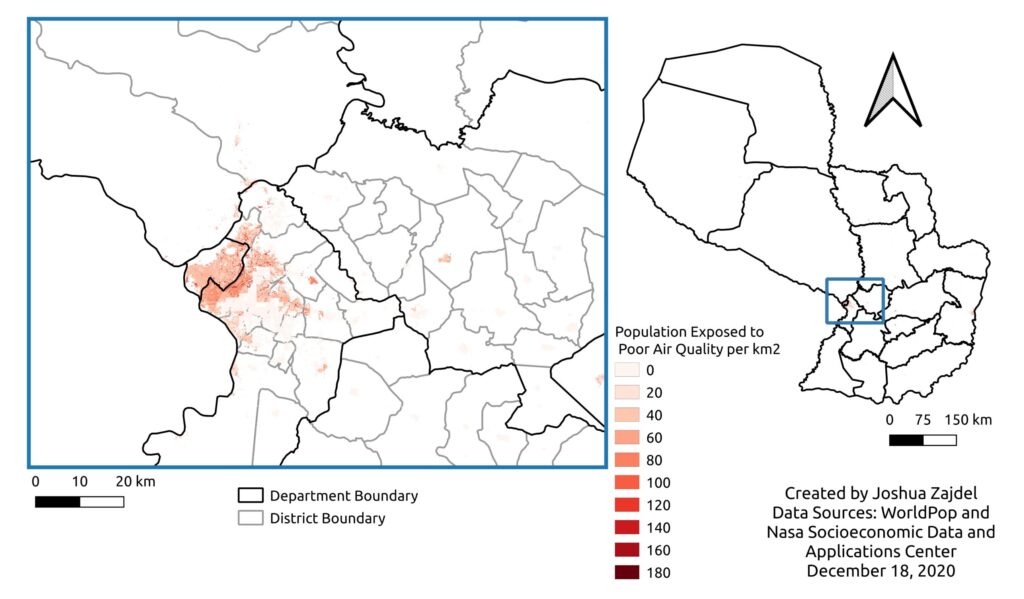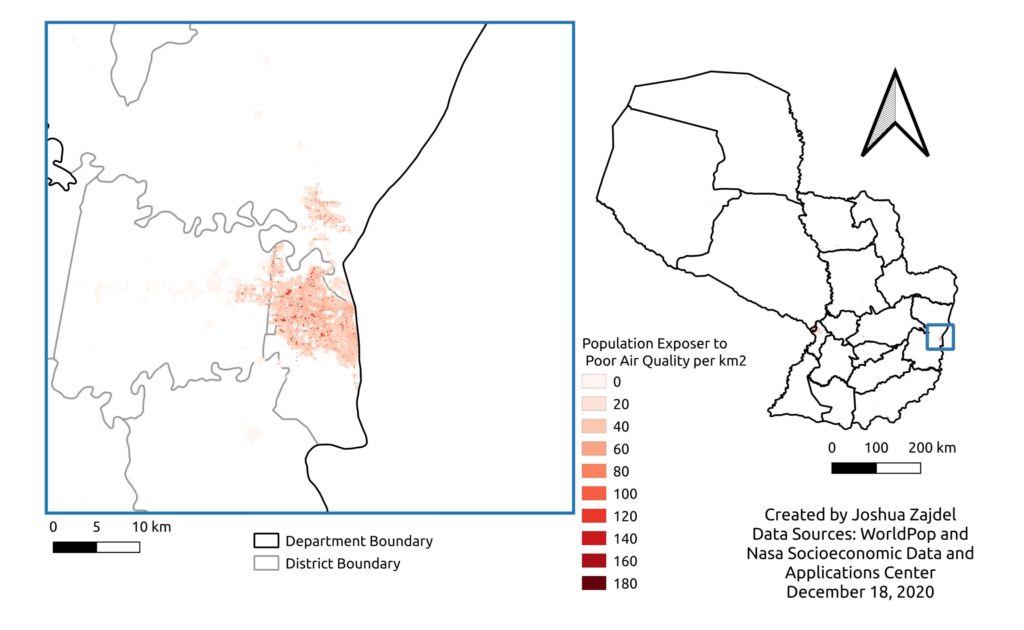The Spatial Distribution of Air Quality and its Impacts on Health and Infant Mortality in Paraguay
Poor air quality in Paraguay is heavily localized with the majority of the affected populations living in only a few neighborhoods.
A key goal of SDG 11, sustainable cities and communities, is to achieve clean air quality. Air quality can be measured in several ways, including the presence of ozone, the levels of nitrous oxides, or the concentration of PM2.5 (particulate matter in the air that is 2.5 micrometers in size or smaller). PM2.5 has several sources and can include organic material such as dust, pollen, or sea salt. However, PM2.5 is also produced through industrial activity like vehicle emissions and manufacturing.
High levels of PM2.5 are associated with a myriad of negative health outcomes. Children raised in areas with poor air quality are more likely to develop asthma, experience chronic bronchitic symptoms, have neurological impairments, and even have a higher risk of childhood leukemia. Infant mortality has also consistently been found to correlate with poor air quality and recent work has found that an increase of 10 μg m−3 in PM2.5 concentration is correlated with a 9% rise in infant mortality (Heft-Neal et al., 2018).
Unfortunately, estimating the impacts of high levels of PM2.5 can be difficult, particularly in developing countries. Levels of PM2.5 can vary widely, even within a city, and utilizing ground-based sensors can be expensive. Fortunately, satellite-based methods of measuring PM2.5 levels have provided researchers with the ability to estimate the impacts from high concentrations of PM2.5 down to the neighborhood level.
Paraguay is a middle-income South American country that has been seeking to meet the SDGs (UN Sustainable Development Goals Partnerships Platform, 2020). The country is geographically diverse, though the majority of people live in and around the capital, Asuncion, and near the border with Brazil. Current estimates of the average PM2.5 concentration in Paraguay are 12 μg m−3, exceeding the World Health Organization’s (WHO) target of 10 μg m−3 (World Health Organization, 2018), though PM2.5 is not evenly distributed through the country. Using satellite-based methods of PM2.5 quantification and estimates of population distribution, we were able to quantify the average air quality in each neighborhood in Paraguay and assess the neighborhood level impacts that may be affecting health outcomes, such as infant mortality.
Across Paraguay, 2.9 million people are affected by air quality that is above the WHO’s target of 10 μg m−3 PM2.5. However, the distribution of those affected is highly uneven with 76% of those affected by poor air quality living in the departments (the Paraguayan equivalent of States in the U.S) of Asuncion, Alta Parana, and Central (Figure 1; Figure 2). Even within these departments, PM2.5 distribution was highly uneven. In the Central Department, approximately 1.2 million people are affected by poor air quality, however, the majority of those individuals live in just 50 of the 671 neighborhoods in the department (Figure 1).

Similarly, in Alto Parana, approximately half a million people are affected by poor air quality, but the majority of them live in just 15 out of the 702 neighborhoods in the department (Figure 2). In Asuncion, all 68 neighborhoods had individuals impacted by poor air quality. Although, the majority of the people affected live in just 20 out of the 68 neighborhoods in the department (Figure 1).

Overall, 11% of the neighborhoods in Paraguay are impacted by poor quality. Table 1 contains data on the ten neighborhoods with the largest number of people impacted by poor air quality. Currently, the WHO estimates Paraguay to have an infant mortality rate of 17 deaths per 1,000 live births. By achieving the WHO’s recommended level of PM2.5 across the country, Paraguay could potentially reduce its infant mortality rate to 16 deaths per 1,000. However, because the poor air pollution is heavily concentrated within a few districts in Paraguay, the decrease in infant mortality is expected to be localized. Achieving the WHO’s air quality goals in only the ten most heavily impacted neighborhoods in Paraguay could result in three fewer infant deaths per year. Overall, by achieving the WHO’s air quality goals across the country, Paraguay could expect to see 28 fewer infant deaths per year. To achieve these air quality and infant mortality improvements, Paraguay could consider state-specific regulations on vehicle emissions and industrial air pollution.

As Paraguay continues to industrialize, it is important that the country focuses on ways to improve and monitor air quality. Air quality not only has large and numerous impacts on adult population health, but also directly impacts a region’s infant mortality, as our study found (World Health Organization, 208; Heft-Neal et al., 2018). Continued industrialization is likely to increase air pollution and subsequent health issues unless robust air quality policies are implemented. By beginning with the three most heavily impacted departments, Asuncion, Central, and Alto Parana, Paraguay can take decisive action to curb air pollution and public health risks, all while making progress on SDG 11.

